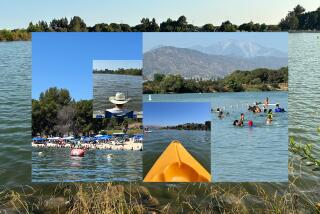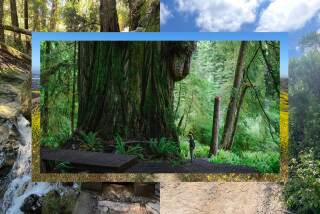Tarnished Natural Jewels : Lakes on the Brink of Death : Conservation: Three unnamed, neglected ponds off Laguna Canyon Road will be turned over to Laguna Beach next week, beginning their hoped-for restoration as linchpins of a new regional park.
- Share via
LAGUNA BEACH — Lake No. 1 is a sick pond, not so golden even on a good day. The slimy muck of its banks is pockmarked with the hoof prints of cattle and lime-green scum bubbles on the surface, attracting buzzing flies.
Elisabeth Brown treads carefully along its shore, dodging cow patties as she talks about the troubles and the promise of this little pond and its two sisters--the county’s only natural lakes.
“What a mess,” the president of Laguna Greenbelt says with a sigh. “I don’t think these lakes have too much longer to go before they are nothing but mud puddles.”
After decades of neglect, cattle grazing and urban pollution, the Laguna Lakes are in such poor shape they are close to ecological collapse. But, beneath all their glaring problems, the potential of true freshwater lakes manage to shine through here, mere yards from busy Laguna Canyon Road.
Next week, two of the three long-neglected lakes, part of the Irvine Ranch for a century, will be turned over to Laguna Beach in its purchase of 2,150 acres of Irvine Co. land in Laguna Canyon. Then the long, slow healing can begin.
Local parks officials and environmentalists have grand hopes for Laguna Lakes, envisioning them as the crown jewels in an immense regional park proposed for the canyon. They believe restoration can create a major stopover for migrating waterfowl as well as a popular resource for nature walks, perhaps even fishing.
A strategy to resuscitate the lakes will be drafted with a $75,000 state grant recently awarded to Laguna Greenbelt, a grass-roots conservation group. Later this month, a management team led by the Greenbelt and including the city of Laguna Beach, the county, the Irvine Co. and the state Coastal Conservancy will begin soliciting bids from environmental consultants for the yearlong study.
The three ponds, which encompass about 20 acres just off Laguna Canyon Road north of El Toro Road, are the only natural lakes in Orange County. Only a smattering of freshwater lakes exist in the arid southern half of California, and most are popular recreational spots such as Big Bear Lake and Lake Elsinore.
“This watershed is unique not just in Orange County but in Southern California, so it is important to preserve,” said Chris Kroll, a project manager for the Coastal Conservancy, a state natural resources agency that awarded the grant to Laguna Greenbelt.
“It is used by migrating waterfowl, and it has great importance for that alone,” he said. “Most other (freshwater) places in California have been drained or filled, so any type of natural system like this has great value.”
All rain and runoff that falls on Laguna Canyon’s 600-acre watershed winds up at the lakes, the low point in the steep canyon. While Lake No. 3, the largest at 12 acres, contains water year round, the smaller two are seasonal and often dry up. Lakes 2 and 3 used to be one, but now are split by Laguna Canyon Road and linked by an old underground pipeline.
Most of the visitors to the little-known lakes are wintering waterfowl and the Irvine Ranch’s grazing cows, because the land is privately owned and fenced off. Only a few fishermen wander in, ignoring the “No Trespassing” signs.
The lakes are so obscure that they don’t even have individual names; they are known unceremoniously as Lakes No. 1, 2 and 3. Lake No. 2 is known to some as Bubbles Pond, in memory of Bubbles the hippopotamus, who died there after escaping from nearby Lion Country Safari in 1978.
“Hardly anybody knows about these lakes,” Brown said, “except anyone born in Laguna who spent their childhood out in the canyons and hills.”
The canyon land was sold by the Irvine Co. “as is,” with all its blemishes. So the cost of the lake restoration, as yet unestimated, must be paid for by public agencies, said Robert G. Fisher, Orange County’s director of harbors, beaches and parks.
County government will probably be responsible for the expense, Fisher said, because the Laguna Lakes are part of 15,000 acres of coastal open space that the county plans to turn into a new regional park. On Tuesday, the Board of Supervisors is expected to approve $2.5 million toward creating Coastal Greenbelt Regional Park, which would be the largest park in Orange County.
Fisher said he hopes that “in addition to a wildlife habitat resource, we can also utilize the (largest) lake for public fishing. I think that would be very nice use of the property.”
Conservationists hope that eventually benefactors will donate restoration funds. In return, a lake might be named after them. “Maybe there will be some guardian angel that will help,” Fisher said hopefully.
The two smaller lakes will be acquired by the city next week as part of the $78-million sale by the Irvine Co., which originally intended to build a 3,200-home development there named Laguna Laurel. Lake No. 3, which is already one-third owned by the city, won’t be completely turned over for several more years.
Despite their poor shape, the Laguna Lakes have managed to retain much of the ambience of true freshwater lakes. On the morning of Brown’s visit, a lone killdeer flittered around, showing off its striking, tri-colored feathers and twin black breast bands. Blackbirds sang, loud and musical, from their perches in willows. Nearby, a cottontail rabbit hopped into the trees while a pair of quail poked around nearby.
Canada geese, mallards, double-crested cormorants and grebes feed at the lakes during migratory periods. Two types of herons, including great blue, nest in the reeds. Bullfrogs and small schools of bluegill, largemouth bass and goldfish swim in Lake No. 3, and deer, raccoons and other critters use them as watering holes.
But the lakes are plagued by troubles that are gradually destroying their ecosystems.
In the late summer of 1989, Lake No. 3 lost so much oxygen that hundreds of bass and carp suffocated. Smaller fish kills were also reported in summer of 1987. The problem was blamed mainly on fertilizer-tainted runoff from storm-water drains in nearby Leisure World. The runoff nourishes mats of algae floating on the surface that gobble up oxygen.
Cows are the source of other chronic problems. Coliform bacteria in the water is a sign it has been contaminated by cow dung, and grazing is disturbing the habitat around the lakes and causing erosion. As a result, the lakes are filling with mud and sediment that turn them the color and consistency of chocolate syrup.
Many of the troubles have been exacerbated by the region’s long dry spell.
“We’ve been in a drought for five years, and that’s their primary problem. They get water from runoff and rain, but we haven’t had any rain,” said Bill Gartland, the Irvine Co.’s director of land development.
In fact, Gartland and Brown said, the lakes may look mucked up now, but they are healthier and contain more water than they have in several years because of heavy March rains.
Several questions still must be answered before the scope and cost of the restoration can be determined. Should the lakes be filled every year or just in wet years? How much muck should be removed from the bottom? Should much recreational activity be allowed or is that incompatible with the needs of wildlife?
Consultants for the Irvine Co. in 1988 estimated that restoring the lakes could cost $1.2 million, plus about $100,000 per year. Perhaps half that work, however, is now unnecessary because it was intended to control runoff from the now-defunct Laguna Laurel development.
The lakes might need nourishment with large amounts of purchased domestic water, which is in short supply and increasingly expensive. Another major improvement, a runoff bypass system for Leisure World, could also be costly.
“It’s not just a question of what’s natural, it’s what’s possible, and where we want it to go from here,” Brown said. “There are about half a dozen obvious things, like removing the eucalyptus from the middle of the lake, and then you have to decide how much further to go.”
Determining what is “natural” for the lakes is difficult, since they have been ignored so long that they have little recorded history. Brown has been unable to find old photos, and Gartland said he hasn’t heard any folksy, anecdotal memories even though the lakes have been part of the Irvine Ranch since the late 1800s.
“The property was managed as a ranch, and nobody cared much about it in the old days,” Brown said. “What happened wasn’t really willful. We were still the Wild West. Even now, in 1991,” she added, “the lakes don’t even have names. Sort of like the old saying, ‘They just don’t get no respect.’ ”
Laguna Lakes Laguna Laurel Property Soon to be owned by Laguna Beach On Not-So-Golden Ponds After years of problems from drought to urban waste, the Laguna Lakes, the only natural fresh water lakes in Orange County, need some tender loving care. Two of the lakes, part of the Irvine Ranch, become public property of Laguna Beach on Friday, and a team is devising a plan to improve and manage them. At the top of the list is removal of unwanted plants and stopping Leisure World runoff, which contains fertilizers that feed algae and cause fish kills. Lake No. 1 This little pond often dries up in summer and has been dry in recent years, although it now contains small amounts of water after heavy March rains. It has unwanted eucalyptus trees cluttering its middle and pockets of green algae scum. Cattle have eroded its banks with their hoofs and their munching of vegetation. Laguna Beach will buy this lake as part of the Laguna Laural Canyon sale on Friday. Lake No. 2 Known by some townspeople as “Bubbles Pond”, this 1.5 acre lake usually contains some water year round, although it has been low after the long drought. It has many reeds and willows, which are good habitat for birds and assorted other critters. But its banks are eroded, unwanted plants have intruded and its water is muddy and contains some slimy algae. Laguna Beach will own it as of Friday. Lake No. 3 At 12 acres, this is by far the largest and the one with the most potential for waterfowl and recreation. Leisure World storm-water drains empty here, filling it with fertilizers, pesticides and soaps. Herons and other birds feed and nest at the lake, which contains some bass, bluegill and other fish. Fish kills have resulted from buildup of fertilizer-fed algae that is gobbing up the lake’s oxygen. The city already owns one-third of this lake but won’t own the rest for at least several years under a contract with the Irvine Co. NEW REGIONAL PARK
Supervisors are expected to designate Laguna Laurel land as county’s largest preserve. A1
More to Read
Sign up for Essential California
The most important California stories and recommendations in your inbox every morning.
You may occasionally receive promotional content from the Los Angeles Times.









